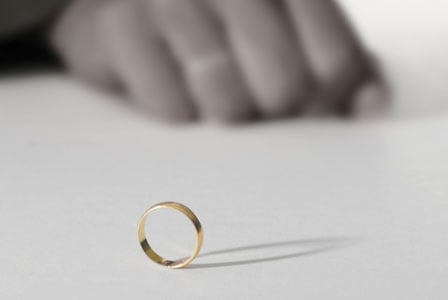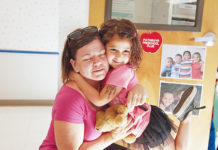
Author Brian Vallee talks about his book The War on Womenand about domestic violence.
The book was shelved in theWomen’s Studies section, which could be found, as the store clerk helpfully pointed out, right next to the True Crime ection. “Not that that’s a judgment or a statement or anything,” he quickly added.
Little did he know how accurate a spot it was, for the book in question is The War on Women: Elly Armour, Jane Hurshman, and Criminal Violence in Canadian Homes by Brian Vallée Key Porter, 2007).
Vallée a writer and investigative journalist, is perhaps most famous for his 1986 book Life With Billy (Seal, 1986), which recounted the story of Jane Hurshman, a Nova Scotia woman who eventually killed her abusive common-law husband, Billy Stafford. Hurshman’s dramatic case, in which she was required to publicly recount the shocking violence and sexual torture her partner inflicted, eventually led to the acceptance of “battered wife syndrome” as a legal defence.
Vallée followed the book with the sequel Life after Billy (Seal, 1995), which chronicled Hurshman’s ongoing struggles with her own personal life after the horrific abuse, her tireless efforts to speak out on violence against women, and her eventual tragic suicide.
Nearly 20 years had passed since Vallée had worked on Life after Billy, and he wasn’t in a hurry to revisit the subject. “I didn’t want to write another book,” he says. “I felt that if you changed the names and the geography, it’s the same story, over and over. But I was wrong.”
The Tragedy Continues
In 2002 Vallée started compiling news-paper articles of women (and sometimes their children) who had been murdered by their domestic partners, and as the file of clippings grew thicker and thicker, he realized that there was much more work to be done.
As Vallée considered starting another book, he was contacted by a 72-year-old woman in Calgary named Ella Armour, who was known to many locals simply as “Miss Elly.” She told Vallée she was fed up with hearing constant news reports about women being murdered and children being abused, and wanted to do something about it. She said she had a story to tell.
It is Miss Elly’s story that forms the framework for The War on Women. Armour married her “knight in shining armour,” Vernon Ince, in her home province of Nova Scotia when she was little more than a girl. The beatings began almost immediately, but, ashamed and confused, Armour tried to hide the severity of the abuse from her family and friends.
In 1951 at the age of 19, with two small children and pregnant with a third, her husband attacked her while Armour’s mother was in the house. In an effort to defend herself from yet another beating, Armour shot Vernon Ince dead with his own hunting rifle.
In recounting Armour’s story, Vallée sometimes compares it to that of Jane Hurshman, and creates not just two interwoven sagas of suffering but a multi-decade cross-section of the aftermath–political, legal, and most of all, personal–of domestic partner abuse.
The reader sees that the fear and anguish caused by violence doesn’t subside when the relationship is over, even when the perpetrator is dead and buried. Despite their willingness to reach out and help others in similar circumstances, Jane Hurshman was so troubled even 10 years after Billy’s death that she took her own life, and Armour had a long history of moving from city to city and job to job while having dysfunctional relationships, especially with her own children.
A Preventable Epidemic
The War on Women is not an easy read, nor is it meant to be. To remind the reader that the two personal stories within the book are not isolated incidents, but only two examples of a larger epidemic, each of 17 chapters opens with a small grey box containing the details of one of the Toronto-area newspaper clippings that Vallée collected.
Chapter after chapter, another woman is killed–sometimes with her children–by the man she lived with or had tried to escape from. The cumulative effect is chilling. What’s even more chilling is that each of these killings occurred during the space of less than a single year.
With a passionate foreword by Stephen Lewis and closing with a comprehensive list of recommendations directed toward law enforcement, the judicial system, and all levels of government, it’s clear that Valléehad more in mind than merely eliciting sympathy from the reader.
A Call to Action
The War on Women is a clarion call to action, from Parliament Hill to the schoolyard, for each of us to become involved, to speak out when they see abuse, to create a climate where it’s acceptable to name it, and to let everyone, especially young people, know that this is not acceptable any longer.
Talking about the format of the book, Vallée says, “I figured that the ‘bookends’ of information would be the best way to present it. I wanted to have this personal story, since most people don’t respond to just numbers, but I also wanted to show that the statistics are pretty awful. Nothing much has changed. It’s disgusting that it’s still such a prevalent thing.”
Our Personal Battlefields
Vallée chose the title The War on Women because he likens what is happening in many Canadian homes as nothing less than a war in which women are the casualties. The dangers are real; while many women are killed, thousands of others are beaten and injured, and many suffer from posttraumatic stress disorder and other serious psychological traumas.
With so many on the domestic battlefield every year, a woman in an abusive relationship is literally fighting for her life every day. Unlike war heroes, however, these women are not honoured, but mostly ignored. They face an alarming lack of resources and support for themselves and their children, and next to nothing in the way of protection from their enemy–the man they are desperately trying to flee.
In fact, battered women who leave or try to leave their partners are in greater danger than those who stay. These are the women we only read about, the wives and mothers who lived in fear, went into hiding, and still were found and killed in retaliation.
Women’s shelters, while desperately needed, are often operating on a wait-list system. Those lucky enough to find a shelter, escape, and survive face a new slew of hurdles once they are ready to try and start over: lack of adequate housing, childcare, and job training; support services and counselling stretched to the breaking point; and always the fear of being found by their abuser.
Are Shelters the Answer?
While Vallée agrees that shelters are necessary and important, he does take issue with the system that requires them in the first place. “It’s something that’s always bothered me–why is it the women and children who are forced out of the family home and put in a shelter with strangers, hiding out and living in fear? Why isn’t the man removed, put into a halfway house, [and] mandatory counselling, and [required] an electronic ankle bracelet–and not allowed to go near the woman and children?”
Neither does Vallée hold back in his critique of the current government response to the issue. “There’s been a real backlash in the last few years, and you can’t even say ‘violence against women’ anymore. You have to say ‘family violence.’ In the name of this so-called ‘gender neutrality,’ our current government is cutting funding to women’s organizations, closing their offices, and removing the ‘equality’ portion from the Status of Women’s mandate. Well, how can we have ‘gender neutrality’ when we don’t even have gender equality?”
Vallée calls for governments to restore funding to women’s organizations, including those that work for advocacy. He laments that certain powerful “men’s rights” groups have been successful in “demonizing” feminists. “These women don’t hate men,” says Vallée “they hate injustice.”
He has no patience for those groups who suggest that men are as much victims of domestic violence as women. He says these organizations use statistics that don’t reflect actual crime data from intimate-partner relationships, which are the numbers that actually count.
“The only numbers I’m interested in are: Who’s dying, who’s in the shelters, and who’s in the hospitals? And there’s no question that there are minuscule numbers of men who’ve been treated wrong by the system in custody cases, or they may live with a bad woman who commits violence against them, but those numbers are so small, while the problem for women is overwhelming. They deserve justice too, but the numbers are so small it’s a red herring.”
Maintain Gun Registry
He also wants to see the Canadian Firearms Registry maintained and updated, as it serves to save the lives of women as well as police officers. “The gun registry combats health care costs in domestic violence cases and protects police officers. The police want it–when they go to a house, they want to know ahead of time if there’s a gun inside, and when a man decides to shoot a woman, 80 percent of the time he uses a legal ‘long gun,’ such as a rifle or shotgun.
“The police officers who work in domestic violence situations should receive additional specialized training,” says Vallée and should be considered elite members of the force. “If they do their work right and are getting the courts behind them, then they are preventing murders. It’s not nice work, but it’s important work. We need to give those individuals the prestige they deserve. Maybe if their prestige were raised, there might be more people looking to do that kind of work.”
Greater Judicial Awareness
Vallée also feels judges need more training to know how to handle intimate-partner abuse cases. When Armour shot and killed her husband, she was charged with what was then called capital murder. Luckily, knowing her circumstances, a jury acquitted her of the charge in a matter of minutes, but the idea of “battered wife syndrome” was still decades away, when Hurshman’s high-profile case would establish it as a legal defence in Canadian courts.
Despite those steps forward, Vallée says there is still a long way to go in Canada’s courtrooms, and judges need to understand the dynamics of these relationships. “Once they know, then they can’t be [misled] in the courts. That’s what’s happening with this backlash; these abusers will often use the court system to further abuse the women in their lives. The women are going in there on faith, and they’re very fearful, and sometimes they’re even cross-examined and humiliated.”
He also adds that charges for abusers need to be tougher from the outset. “Even though they’ve tortured a woman in their homes, often for years, before killing them, they’re often just charged with second-degree murder or manslaughter. That law should change–if there’s been any history of abuse, then the charge should automatically be first-degree murder, and let the jury hear the details.”
The Media has a Role
The court cases, and the day of the crime itself, are often the only time the general public hears about an abused woman, and Vallée singles out the media for this failing. “The newspapers and TV stations should do as they do with military and police deaths; they should be running stories and updates on all these women who are killed and who they are. They’re real people, not just numbers.”
We Can All Do Something
In addition to the sweeping calls for change at the legislative, judicial, and law enforcement levels, Vallée believes that the answer to the problem of violence against women needs to start with education and outreach to young people. “There has to be a huge societal shift in attitudes–society has to be turned on its ear. Look at something like drinking and driving: there’s still a long way to go, but education programs have made it socially unacceptable now. Intimate-partner abuse, too, needs to be made unacceptable. We have to start in the schools and make people aware.”
He suggests that survivors of abuse and their families make presentations at schools, and that more men speak out to teach young people that if they see abuse, they should report it to teachers or police, because oftentimes the victims can’t or won’t. “This happens at all strata of society, and a lot of it is hidden. Less than 30 percent of abuse is even reported. Women are afraid to report it, not just because they’re afraid of their abuser but because they’re afraid that the system won’t protect them.”
Even if a woman does succeed in leaving her abuser, pressing charges, and getting the support she needs to resume her life, there’s no guarantee that everything will get back to “normal.”
“It’s a gross breach of trust,” says Vallée “and there’s a fear that you can never get free of its effects. Jane and Elly both killed their husbands, but did they ever get free of that fear, and have a normal life?” For Vallée the issue of intimate-partner abuse is not just a “women’s issue.” It’s an issue that affects us all, one that each of us can play a role in preventing.
The War on Women: The Statistics
- Number of American soldiers killed in Iraq and Afghanistan by hostile forces from 2000 to 2006: 2,697
- Number of American soldiers killed in Iraq and Afghanistan in “nonhostile incidents” from 2000 to 2006: 726
- Number of American women shot, stabbed, strangled, or beaten to death by their intimate male partners from 2000 to 2006: more than 8,000
- Number of Canadian soldiers killed in Afghanistan (including four who died in accidents and six killed by “friendly fire”) from 2000 to 2006: 44
- Total deaths in seven years of Canadian frontline military and law enforcement: 101
- Number of Canadian women shot, stabbed, strangled, or beaten to death by their
intimate male partners from 2000 to 2006: more than 500 - Estimated number of American women aged 18 and older who are victims of nonlethal domestic abuse: 5.3 million
- Estimated annual US health care costs of intimate-partner violence (including direct medical and mental health care, lost productivity, and lost earnings due to homicide): more than $5.8 billion
- Estimated annual Canadian costs of intimate-partner violence (including direct medical and mental health care, lost productivity, lost earnings, and police, court, and prison costs): more than $4 billion
- Number of shelters in North America for battered women and their children: approximately 2,500
- Number of women and children in the US who seek safety in shelters annually: more than 300,000
- Number of women and children in Canada who seek safety in shelters annually:
between 90,000 and 100,000
Source: The War on Women: Elly Armour, Jane Hurshman, and Criminal Violence in Canadian Homes (Key Porter, 2007) by Brian Vallée





























